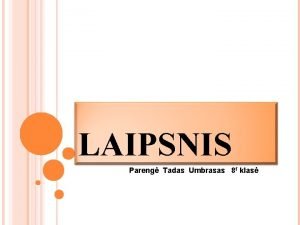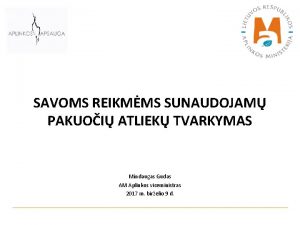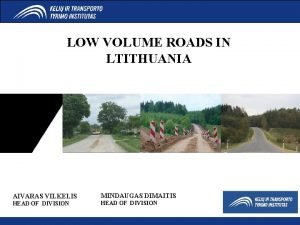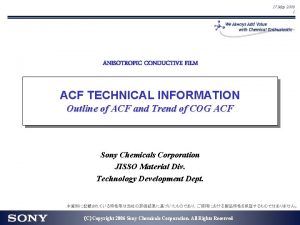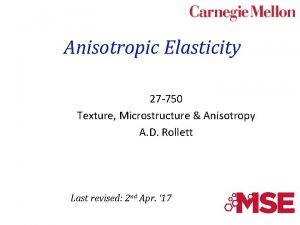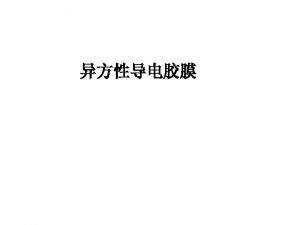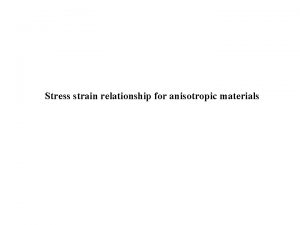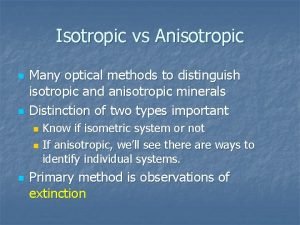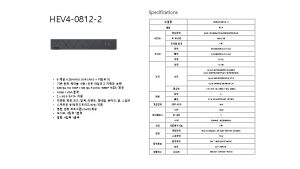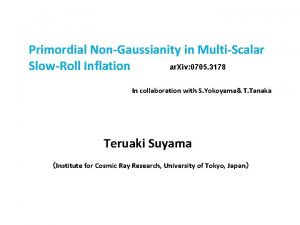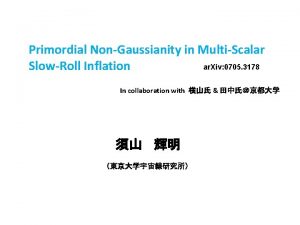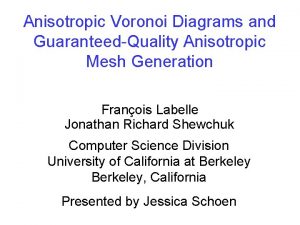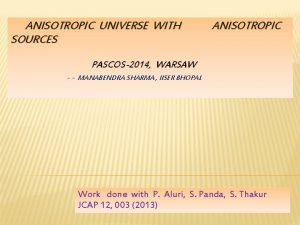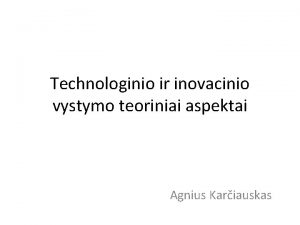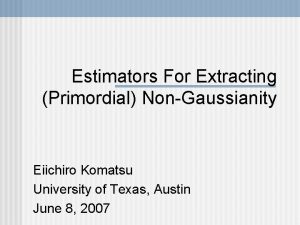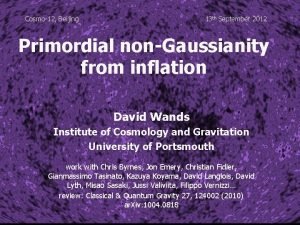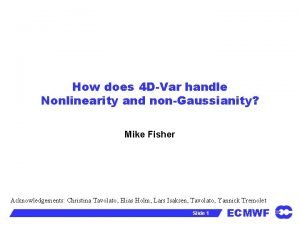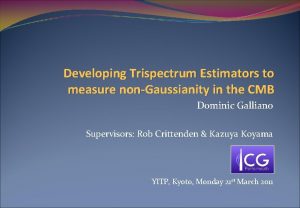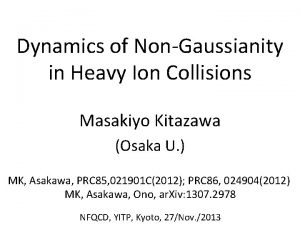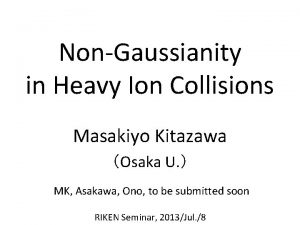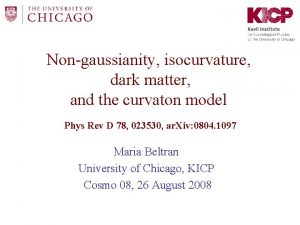Anisotropic nonGaussianity ar Xiv 0812 0264 Mindaugas Kariauskas


















- Slides: 18

Anisotropic non-Gaussianity ar. Xiv: 0812. 0264 Mindaugas Karčiauskas work done with Konstantinos Dimopoulos David H. Lyth

Density perturbations ● Primordial curvature perturbation – a unique window to the early universe; ● Origin of structure <= quantum fluctuations; ● Usually light, canonically normalized scalar fields => statistical homogeneity and isotropy; ● Statistically anisotropic perturbations from the vacuum with a broken rotational symmetry; ● The resulting observable. is anisotropic and may be

Statistical homogeneity and isotropy ● Density perturbations – random fields; ● Density contrast: ; ● Multipoint probability distribution function : ● Homogeneous if the same under translations of all ● Isotropic if the same under spatial rotation; ;

Statistical homogeneity and isotropy ● Assume statistical homogeneity; ● Two point correlation function ● Isotropic if for ; ● The isotropic power spectrum: ● The isotropic bispectrum:

Statistical homogeneity and isotropy ● Two point correlation function ● Anisotropic if even for ● The anisotropic power spectrum: ● The anisotropic bispectrum: ;

Isotropic Random Fields with Statistical Anisotropy - preferred direction

Present Observational Constrains ● The power spectrum of the curvature perturbation: & almost scale invariant; ● Non-Gaussianity from WMAP 5 (Komatsu et. al. (2008)): ● No tight constraints on anisotropic contribution yet; ● Anisotropic power spectrum can be parametrized as ● Present bound (Groeneboom, Eriksen (2008)); ● We have calculated of the anisotropic curvature perturbation - new observable.

Origin of Statistically Anisotropic Power Spectrum ● Homogeneous and isotropic vacuum => the statistically isotropic perturbation; ● For the statistically anisotropic perturbation <= a vacuum with broken rotational symmetry; ● Vector fields with non-zero expectation value; ● Particle production => conformal invariance of massless U(1) vector fields must be broken; ● We calculate for two examples: ● End-of-inflation scenario; ● Vector curvaton model.

δN formalism ● To calculate we use formalism (Sasaki, Stewart (1996); Lyth, Malik, Sasaki (2005)); ● Recently in was generalized to include vector field perturbations (Dimopoulos, Lyth, Rodriguez (2008)): where , , etc.

End-of-Inflation Scenario: Basic Idea Linde(1990)

End-of-Inflation Scenario: Basic Idea - light scalar field. Lyth(2005);

Statistical Anisotropy at the End-of-Inflation Scenario - vector field. Yokoyama, Soda (2008)

Statistical Anisotropy at the End-of-Inflation Scenario ● ● ● Physical vector field: Non-canonical kinetic function Scale invariant power spectrum => Only the subdominant contribution; Non-Gaussianity: where , - slow roll parameter ; ;

Curvaton Mechanism: Basic Idea ● Curvaton (Lyth, Wands (2002); Enquist, Sloth (2002)): ● light scalar field; ● does not drive inflation. Curvaton Inflation HBB

Vector Curvaton ● Vector field acts as the curvaton field (Dimopoulos (2006)); ● Only a small contribution to the perturbations generated during inflation; ● Assuming: ● scale invariant perturbation spectra; ● no parity braking terms; ● Non-Gaussianity: where

Estimation of ● In principle isotropic perturbations are possible from vector fields; ● In general power spectra will be anisotropic => must be subdominant ( ); ● For subdominant contribution can be estimated on a fairly general grounds; ● All calculations were done in the limit ● Assuming that one can show that ;

Conclusions ● We considered anisotropic contribution to the power spectrum and ● calculated its non-Gaussianity parameter . ● We applied our formalism for two specific examples: end -of-inflation and vector curvaton. ●. is anisotropic and correlated with the amount and direction of the anisotropy. ● The produced non-Gaussianity can be observable: ● Our formalism can be easily applied to other known scenarios. ● If anisotropic is detected => smoking gun for vector field contribution to the curvature perturbation.

 Mindaugas valuckas
Mindaugas valuckas Mindaugas vaina
Mindaugas vaina Mindaugas grigonis
Mindaugas grigonis Mindaugas kaziukonis
Mindaugas kaziukonis Laipsniai su naturaliuoju rodikliu
Laipsniai su naturaliuoju rodikliu Mindaugas černius
Mindaugas černius Mindaugas civilka
Mindaugas civilka Gudas mindaugas
Gudas mindaugas Jonas rutkauskas
Jonas rutkauskas Mindaugas umbrasas
Mindaugas umbrasas Dwmsetwindowattribute
Dwmsetwindowattribute Aivaras vilkelis
Aivaras vilkelis Anisotropic conductive film
Anisotropic conductive film Isotropic meaning
Isotropic meaning Anisotropic properties
Anisotropic properties 3m anisotropic conductive film adhesive 5363
3m anisotropic conductive film adhesive 5363 Orthotropic and anisotropic materials
Orthotropic and anisotropic materials Anisotropic
Anisotropic Anisotropic vs isotropic
Anisotropic vs isotropic




